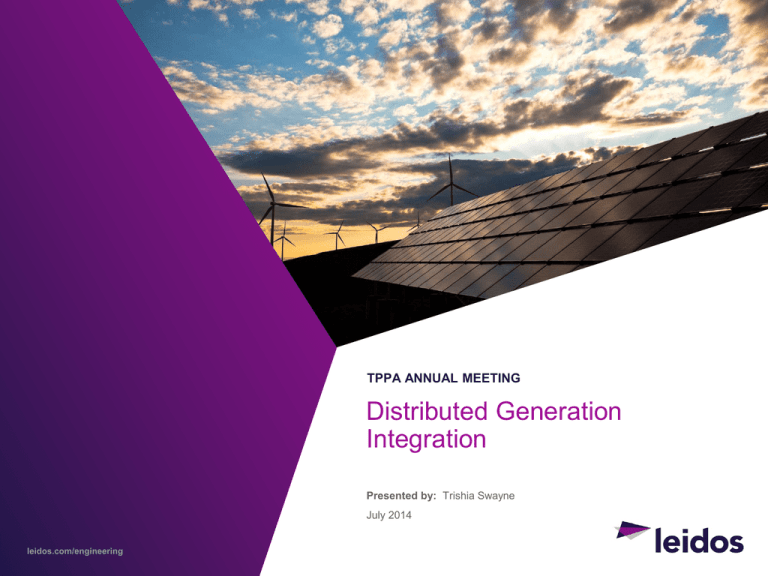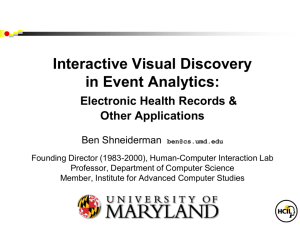
TPPA ANNUAL MEETING
Distributed Generation
Integration
Presented by: Trishia Swayne
July 2014
leidos.com/engineering
Introduction and Agenda
>
Perspectives of DG Impact
>
Applicable Standards
>
Basic Data and Assumptions
>
Recommended Analysis
>
>
Short Circuit Analysis
>
Voltage and Capacity Review
>
Voltage Flicker Review
>
Stability Analysis
>
Protection and Islanding
>
Grounding Requirements
Conclusions
DG = distributed generation
leidos.com/engineering
© Leidos. All rights reserved.
2
Perspectives of DG Impact
leidos.com/engineering
3
© Leidos. All rights reserved.
Applicable Standards
What are the applicable industry standards to help you
understand and study DG impacts?
>
National Renewable Energy Laboratory (NREL)
>
Electric Power Research Institute (EPRI)
>
IEEE 1547 – “Standard for Interconnecting Distributed Resources
with Electric Power Systems”
>
IEEE 1547.7
“Guide for Conducting
Distribution Impact
Studies for Distributed
Resource
Interconnection”
>
UL1741
“Standard for Inverters,
Converters, and
Controllers for Use In
Independent Power
Systems”
>
IEC 61000-3-7 and
IEEE 1453
>
Utility and state DG
interconnection
requirements
leidos.com/engineering
>
ANSI C84.1
“American National
Standard For Electric
Power Systems and
Equipment – Voltage
Ratings (60 Hertz)”
4
© Leidos. All rights reserved.
Basic Data and Assumptions
›
›
›
›
›
Load data – from utility; substation
and feeder level; 15-minute or
smaller increments best
Power factor – from utility and
inverter specs; substation and
feeder level historical, requirements
for inverters from utility
Modeling components –vary by
software
Fault current contribution –
from inverter manufacturer
›
Substation source impedance –
from utility
›
Substation transformer
specifications – from utility; includes
load tap changer or regulator
settings
›
Line regulator and capacitor
specifications – from utility
›
Protective device locations and
settings – from utility
›
DG specifications
Step-up transformer specifications –
from DG site developer
leidos.com/engineering
5
© Leidos. All rights reserved.
Basic Data and Assumptions
Example from CYME model; recloser and switch, step-down transformers,
inverters/PV modules, grounding banks. 7.5 MW site
CYME = xx
leidos.com/engineering
PV = photovoltaic
© Leidos. All rights reserved.
6
Short Circuit Analysis
DG Status
Fault Location
LG (Amps)
LG (MVA)
LLL (Amps)
LLL (MVA)
OFF
PCC
3,561
81
4,727
108
ON
PCC
6,038
138
5,043
115
OFF
13 kV Bus Substation
8,937
204
8,856
202
ON
13 kV Bus Substation
9,676
221
9,168
210
OFF
138 kV Bus Substation
28,540
6,822
34,057
8,141
ON
138 kV Bus Substation
28,548
6,824
34,089
8,148
PCC = point of common coupling
leidos.com/engineering
LLL = three phase fault type
© Leidos. All rights reserved.
LG = line to ground
7
Voltage and Capacity Review
Scenario
PCC
DG
Status
V
KVAR
KW
Substation
P.F.
V
KVAR
KW
P.F.
Minimum
Voltage
Maximum
Voltage
V
Location
V
Location
5.472 MVA Peak at -99.6% P.F. – 1.5 MW DG added
1
OFF
125
-929
2,656 -94.3% 125.5
-378
5,624 -99.8%
124.5
1664756
125.5
Substation
2
ON
125.2
-852
1,198 -80.6% 125.5
-337
4,153 -99.7%
124.7
1664756
125.5
Substation
2,031 100.0%
124.9
1208871
125.4
Substation
124.9
1208871
125.4
Substation
1.974 MVA Peak at -99.9% P.F. – 1.5 MW DG added
3
OFF
125.2
-709
961
-80.1% 125.4
22
4
ON
125.4
-641
-497
-61.2% 125.4
81
570
P.F. = power factor
leidos.com/engineering
© Leidos. All rights reserved.
98.9%
8
Voltage and Capacity Review
LTC = load tap changer
leidos.com/engineering
© Leidos. All rights reserved.
9
Voltage and Capacity Review
leidos.com/engineering
10
© Leidos. All rights reserved.
Voltage and Capacity Review
leidos.com/engineering
11
© Leidos. All rights reserved.
Voltage Flicker Review
Pst planning level of 0.9 from the IEC® 61000-3-7 standard is essentially equal
to the line of irritation on the IEEE® 519 chart.
IEEE is a registered trademark of IEEE Corporation in the U.S. and/or other countries.
IEC is a registered trademark of the International Electrotechnical Commission in the U.S. and/or other countries.
leidos.com/engineering
© Leidos. All rights reserved.
12
Voltage Flicker Review
Per IEC® 61000-3-7 standard for medium voltage systems
Allowable (1)
Calculated
Pst
0.90
0.475
Plt
0.70
0.446
Note: (1) From IEC 61000-3-7 Table 2 for medium voltage systems.
leidos.com/engineering
13
© Leidos. All rights reserved.
Voltage Flicker Review
1 MW unit adjusted output
800.00
1.000
0.900
700.00
0.800
600.00
0.700
kW
500.00
0.600
400.00
0.500
0.400
300.00
0.300
200.00
PV Output
0.200
100.00
0.100
0.00
Pst
Pst Limit
0.000
0 2 4 6 8 10121416182022 0 2 4 6 8 10121416182022 0 2 4 6 8 10121416182022
Hours(May 29 th – 31 st, 2011)
leidos.com/engineering
14
© Leidos. All rights reserved.
Stability Analysis
>
Generally for larger sites, greater than 5 MW
>
Should be considered for a queue of larger DG sites to review the
cumulative impact
>
Typically use PSLF or PSS/E
>
Tests include fault ride-through characteristics, voltage transients,
regulating device behavior, islanding, critical clearing time, and
evaluation of power swings for out-of-step protection
PSLF = positive sequence load flow
leidos.com/engineering
PSS/E = power system simulation for engineering
© Leidos. All rights reserved.
15
Protection
>
Fusing or mid-stream recloser in line with proposed DG site
>
Recloser/gang operated air break (GOAB) switch/main breaker
requirements at PCC
>
Utility protection versus DG site protection and ownership and control
at PCC
>
Feeder breaker/relay settings reviewed with DG online
>
Is DG offline before feeder reclose?
>
Do the inverters respond fast enough to not cause unintentional
islanding?
>
Solutions: DTT (fiber, radio, etc.); recloser/relay protection at PCC looking out to the electric
system
DTT = direct transfer trip
leidos.com/engineering
© Leidos. All rights reserved.
16
Islanding
When is islanding a concern:
1.The DG aggregate capacity is more than one-third of the minimum load of the
Local EPS (for mixes of DG); if all PV, islanding is a concern when aggregate
PV is 100% of daytime minimum load or more.
2.The DG is not certified to pass an applicable non-islanding test.
3.The DG installation does not contain reverse or minimum power flow
protection, sensed between the Point of DG Connection and the PCC, which
will disconnect or isolate the DG if power flow from the Area EPS to the Local
EPS reverses or falls below a set threshold.
4.The DG does not contain other non-islanding means, such as a) forced
frequency or voltage shifting, b) transfer trip, or c) governor and excitation
controls that maintain constant power and constant power factor.
EPS = electric power system
leidos.com/engineering
© Leidos. All rights reserved.
17
Grounding Requirements
Preferred/typical effectively grounded transformer configurations for a
four-wire system:
1.
Grounded wye (primary) – Delta (secondary)
2.
Grounded wye (primary) – Grounded wye (secondary), with generator neutral
connected to neutral/ground of transformer
3.
Other configurations with grounding transformer banks at DG site
4.
Ungrounded neutral at generation source if feeder load = 3 X source
leidos.com/engineering
18
© Leidos. All rights reserved.
Conclusions
›
Standards and utility interconnection
requirements are important documents to study,
understand, and follow for analysis.
›
Utilities are unique in requirements, facility
specifications, protection philosophy, planning
criteria, etc.
›
Not all DG sites need detailed analysis. Initial
screening will detect that.
leidos.com/engineering
19
© Leidos. All rights reserved.
Thank You
Trishia Swayne, P.E.
615.431.3227
Trishia.S.Swayne@leidos.com
Visit us at leidos.com/engineering
leidos.com/engineering
20
© Leidos. All rights reserved.







